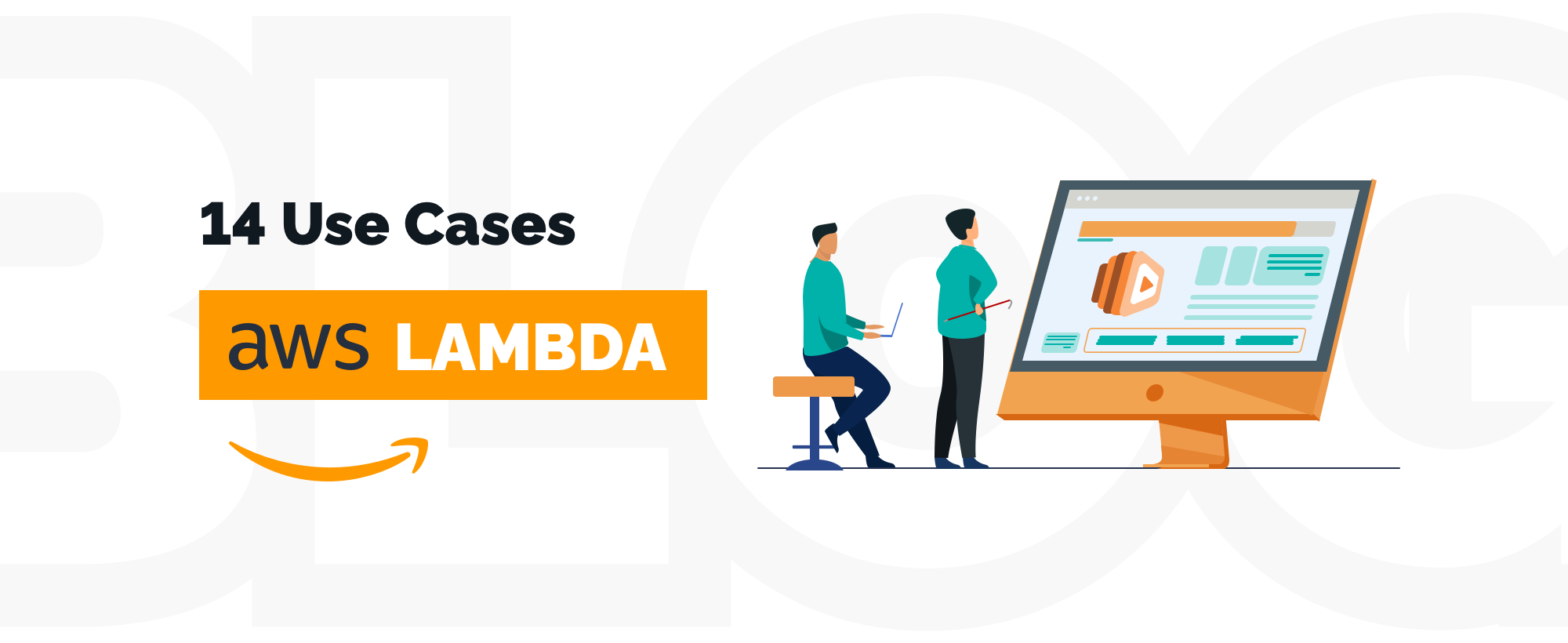14 Use Cases for AWS Lambda: How to Make the Most of It

Web Expert at Techmagic, full-stack developer, coach and speaker. Passionate about JavaScript, Cloud Computing and Serverless.

How can you improve serverless architecture with Amazon Web Services? Explore unconventional AWS Lambda use cases.
Introduction
Since 2014, the year when AWS Lambda — an event-driven computing platform — launched, it has become the most trending cloud strategy. By 2020, AWS Lambda has more than 100,000 active users each month, conducts trillions of monthly executions, and supports 22 global regions. AWS Lambda serves the purpose of minimizing infrastructure maintenance by running the code in response to triggers.
A common example revolves around Amazon Storage Service (S3). You can assign AWS Lambda a function to automatically resize an image every time it has been uploaded to S3. The triggering event is the image being uploaded to S3, and Lambda instantly resizes it.
Besides saving time on infrastructure management, companies also cut their expenses. When using Lambda, customers do not pay for code storage but only for the execution of functions — thus, they will be billed only when an image has been resized.
14 Outstanding Use Cases for AWS Lambda
The migration to serverless architecture by the biggest players like Netflix, the New York Times, and A Cloud Guru brought them significant benefits. Why has AWS Lambda become so important and attractive to many powerful companies? What is so great about this service?
Building a Serverless Website
Retreating from maintaining servers, even virtual servers has helped businesses to focus resources and energy on their core functionalities and tasks. Instead of dealing with the everyday minutiae of managing servers, developers can concentrate on the actual product. Together with DynamoDB, Amazon S3, and Amazon Cognito, AWS Lambda helps them build a website or an application without managing servers and operating systems. Here is how it works:
Website content is hosted on AWS S3 and DynamoDB serves as a NoSQL database. At the same time, Amazon Cognito plays the role of user authentication and performs managerial tasks, whereas AWS Lambda creates functions to access the database.
You can build an e-commerce website that applies Amazon Lambda use cases for managing payments, carts, and building an engine. Alternatively, you can build a dynamic web page and avoid losing data due to EC2 termination by applying two Lambda functions.
Authentication
Amazon Cognito, paired up with AWS Lambda, carries out the personalization of your authentication routine. We are shifting towards a more personable and individual communication, even with businesses. Link your Lambda function to the following triggering sources: sign-up and sign-in to ensure an appropriate set of questions, authentication challenge to make the sign-in process secure, custom message to answer the particular questions, and requests most efficiently, and more.
For example, before sending out a confirmation email to a customer, Amazon Cognito will check with your Lambda function, which gives you a chance to tailor the text and make it personable and helpful. The common triggers here are a request for a new password or important contact information as well as a letter of confirmation.
Mass Emailing
The New York Times and other huge corporations have to send billions of transactional emails each year, along with newsletters and various articles. Mass emailing has become an essential part of every marketing strategy. However, it’s quite expensive and requires technical expertise.
One of the best use cases for AWS Lambda goes well together with Simple Email Service (SES) and assists you in arranging an affordable in-house email flow, whereas your email list will be safely locked in S3. Here is how it works:
A user uploads a CSV file, which is itself a trigger for an S3 event that evokes a Lambda function that adds the file to DynamoDB — the database — and immediately passes on emails to the newly uploaded addresses.
Real-Time Notifications
Amazon Simple Notification Service (SNS) is in charge of topic development and defining which subscribers will be informed about it. The assigned Lambda functions can alter the message and carry out a publication.

Chatbots
Chatbots have become an essential part of business operations and user experience; however, building and maintaining a chatbot continues to be challenging and expensive. Building a scalable chatbot architecture is one of the most prominent use cases for Lambda.
Set up your code logic to trigger when the user contacts the bot. These commands are API requests executed through API Gateway. Due to Lambda’s event-triggering nature, you will save a lot of resources and money.
Media Transformation
Building a multi-platform media expands the list of use cases for Amazon Lambda. Nowadays, applications need to be developed cross-device, which requires high costs and immense effort from the development team. AWS Lambda can solve this issue and automate the process:
- No need to resize your image archive when changing the design;
- No need to store images in every format and hold on to old versions.
Real-Time Data Processing
Analyzing the data metrics to process data in real time and react to it is another one of the use cases for using AWS Lambda. Amazon Kinesis Stream is used for capturing data from the website, whereas Lambda automatically scales the number of functions to satisfy the stream.
By using the stream-based AWS, you arrange your data sources across your website. These data sources send data to the stream, which executes a Lambda function. Alternatively, you can use a manual invocation applying RequestResponse type.
If you have a website or application that needs to have a capability of quick processing of large volumes of information in real time, Kinesis and Lambda might be perfect for you. Other benefits include testing new features and monitoring of customer experience.
Custom Workflows
Workflows are repeatable patterns that should be executed after a certain event. AWS Lambda paired up with Step Functions makes it possible to keep the functions short and easy to test. The combination of two can be used for customer onboarding to simplify the learning curve, cart management to make it more user-friendly, and loyalty programs to convert one-time clients into recurring ones. For example, Foodpanda utilizes Step Functions paired with Lambda to better their delivery application, shorten the delivery times, and boost the customer experience.
Change Data Capture
Tracing the changes in the database accounts for one of the best use cases for AWS Lambda. Either you want to analyze your data before locking it in the database, or keep track of the changes made within the database, DynamoDB and Lambda is the perfect duo.
By adding DynamoDB Streams to your database, you can see which data has been updated and modified inside the database. You can also access old files by creating backups on S3 as well as notify your SNS function to send updates to the subscribers whenever new items are available.
Netflix uses AWS Lambda together with DynamoDB to keep its database up-to-date when new files are added.

Alexa
Being a popular virtual assistant, Alexa translates human speech into a programmatic action. You can create a simple function that will trigger a certain Lambda response; for instance, Alexa will find the nearest coffee shop.
Alexa has the following functions:
- Skill Handler Function provides the custom logic that needs to be executed in order to meet the user’s needs;
- Third-Party Functions ensure interactions with third-party services like databases;
- Custom Alexa Skill Set triggers the handler function as a reaction to the voice command.
Image Recognition Engine
An additional use case with serverless Lambda can be used to keep up with a large number of image uploads. To manage it in the most effective way, you can create several workflows where one will execute the next one. This is how it works:
The first function is data extraction from the image, followed by the identification of an object in the image. The next function will generate a thumbnail and finally report back to the database.
This is only an example; you can tailor the pattern to meet your goals. For instance, you can automatically crop the images to identify the main object.
Text-to-Speech
In combination with Lambda, Amazon Polly enriches AWS Lambda use cases by synthesizing speech and ensuring shorter response times, which is an important part of real-time communication. This is how it works:
A new file in S3 executes a Lambda function that starts an MP3 generating process as well as stores the copy of the data in the database. The second Lambda function is responsible for executing the conversion of the text into the audio file.
Efficient Monitoring
Use CloudWatch Events rules to create Lambda functions by applying one of the following action plans:
- Alarm Threshold Breaches, which implies that a Lambda function will be triggered when your CPU is working improperly or incomprehensibly. CloudWatch will inform the development team and stop inefficient instances;
- Cloudwatch Logs, where a Lambda function will watch over underperforming instances and let the team know about them.
Personalized Content
Providing personalized content is one of the most relevant use cases for using Lambda. Every application is looking for a way to personalize the content and news feed. Luckily, you no longer need a complex architecture in order to ensure personalization. AWS Lambda allows you to start easily and figure it out on the go.
Reasons to Use Lambda for Your Project

- Lower costs
As you pay only when the functions have been executed, you save a lot of money on unnecessary functions. Furthermore, AWS rounds up the cost to the nearest 100 milliseconds as opposed to the nearest hour, which is a common policy among cloud providers.
Big players like Heavywater Inc ended up saving roughly 86% on their monthly bill — they went from paying $30,000 per month to $4,000. But you don’t have to be a large corporation to take advantage of the attractive saving plans. For smaller companies, the overall expense cut is also about 85%.
Read more about AWS pricing models and principles to know what cause this cost reducing.
- Automatic scalability
When your website or application grows and expands, it needs scaling-up to ensure a smooth transaction. To avoid complications and system delays and failures, AWS Lambda conducts automatic upscaling. The best part is that you don’t need to be involved and actually do something; it just happens automatically in correlation with the number of server requests.
- Quick development
AWS Lambda facilitates easier and quicker DevOps by eliminating the main issues of system engineering. The continuous delivery loses its value since developers can write code on the vendor console. This allows them to focus on new features and improvements.
- Less operational management overheads
Due to auto-scaling, developers save time on server maintenance and can concentrate on more important things like innovations. Since this serverless solution does not require any maintenance, you will also save money on staff.
- Industry-leading customer service
Amazon has been on the market for a while and has earned an impeccable reputation, especially for customer experience. Many popular peer-review web pages have selected AWS Lambda as the leader of the industry.
TechMagic AWS Lambda Case Studies
TechMagic is a AWS / Serverless development company and certified partner of Serverless Framework, which specializes in web application development. Using services like API Gateway, DynamoDB, Step Functions, and combining these with AWS Lambda, TechMagic builds scalable and cost-efficient applications.
We have helped Elements.cloud build an auto-scaling and fully-tolerant architecture. In order to lower their expenses and relieve them of responsibility for infrastructure maintenance, we shifted from EC2 instances to partial serverless architecture through the means of AWS Lambda.
Interested to learn more about our AWS expertise?
Learn moreConclusion
Serverless computing allows you to forego infrastructure maintenance and delegate it to AWS. Serverless development significantly reduces the time-to-market and cuts the overall expenses. Although keep in mind that serverless computing is not a plaster for all sores. Like everything in the world, it does not offer a universal cure that will handle all your limitations. Contact experts to consult on your project and see the benefits AWS Lambda has for you.



 Software Development
Software Development
 Security Services
Security Services
 Cloud Services
Cloud Services
 Other Services
Other Services
















 TechMagic Academy
TechMagic Academy
 linkedin
linkedin
 facebook
facebook
 twitter
twitter






















